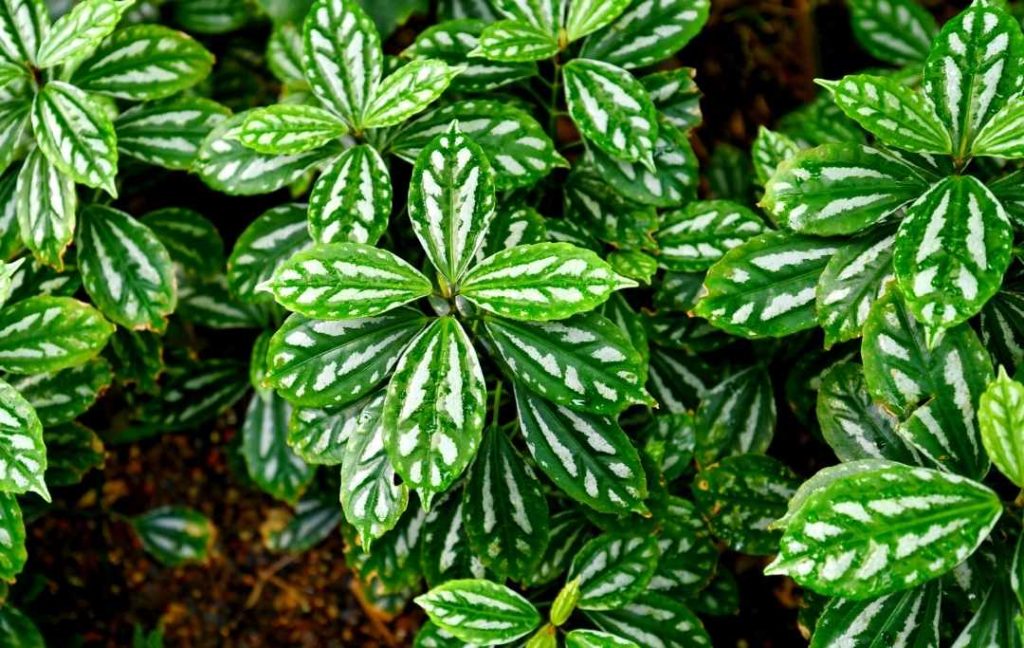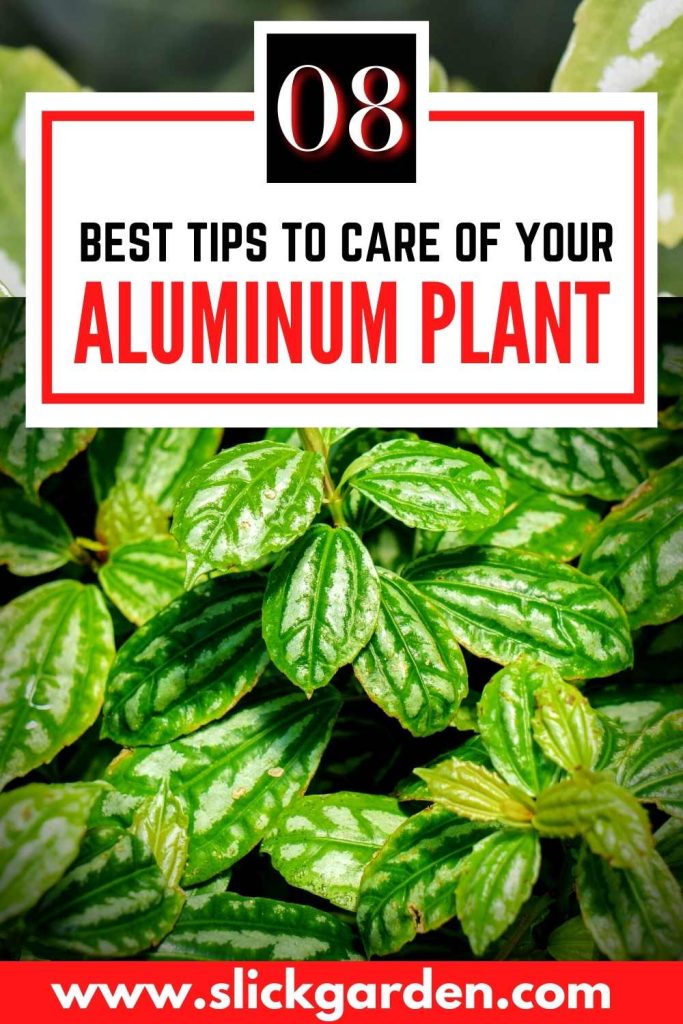Aluminum plants belong to the Urticaceae family. Aluminum plants have pointed leaves splashed in a metallic silver that will add additional appeal to your growing area.
You can grow aluminum plants as houseplants for decorating your home. This is an evergreen plant that has small, significant flowers. The flowers of this plant are not as ornamental as their leaves.

This plant can’t grow very tall, the height of the plant can be reached 6 to 12 inches on 15 to 31cm. This plant has spread to nature and you can grow them in hanging baskets.
Propagating Aluminum Plant
If you take care of your aluminum plant then it can last up to three years. The easy way of propagating aluminum plants is by cutting. The succulent-like leaves easily grow from cuttings.
Make sure the cutting you get should be from a healthy plant. The best time for taking the cuttings is in the early days of summer or spring. After taking the healthy cutting cut the tip.
Now remove the lower leaves from the cutting and place this cutting in moist soil or a glass of water. If you are preparing your cuttings in water then make sure you change the water regularly when it starts looking cloudy. After two weeks, you will see the roots will start developing.
In case if you are placing cuttings in the soil then make sure the soil should be moist but not soggy. The tiny roots start emerging within 2 weeks and after six to eight weeks you will see the ammonium plant has an established root system.
The suitable temperature for the growth of your aluminum plant is about 70 degrees. A perfect temperature is needed for the healthy development of the root system. If you are growing aluminum plants in the pot or container then make sure your pot or container has drainage holes at the bottom.
How Fast Do Aluminum Plants Grow?
Aluminum plants can grow very fast. If your plant gets all the suitable conditions and you are fulfilling all the requirements and needs of your plant then you will see your plant will grow at high speed.
In this article, we are going to discuss with you how to care for your aluminum plant and you will get these ornamental leaves for a longer time.
Read More
- Budget-Friendly Pots And Planters For Indoor Plants
- How To Make Houseplants Grow Faster?
- How To Grow Calla Lily From Seeds?
Aluminum Plant Care Tips
Although you can easily maintain aluminum plants, favorable growing conditions are essential. The first important thing you should have is to plant aluminum plants in a larger pot because the roots of this plant can outgrow the pot and break through the container.
As the plant grows, you should transplant it into an even larger pot. If you are living in a cold climate then you should grow aluminum plants as a houseplant.
1: Light
Light is an important factor for the growth of any plant. In the same way, aluminum plants also need at least an hour of sunlight daily. But keep in mind that too much sun can scorch the leaves and turn them brown.
If you are growing aluminum plants outside in your garden then you should choose the shady location. It is suggested that partial shade is recommended for growing aluminum plants.
2: Soil
Well-drained and which soil is needed for the healthy growth of your aluminum plant if you add organic matter to the soil then it will provide all the basic nutrients to the plant.
The pH of the soil is not very important for growing aluminum plants. For the nourishment of aluminum plants, you need soil that is rich in organic matter.
If you are growing your aluminum plant in a container or pot then you can use a high-quality potting mix. When you decide to grow aluminum plants in a pot, container, or raised bed then you can maintain the fertility of the soil very easily which is not possible when you grow plants in the ground.
3: Water
Moisture is very important for aluminum plants, especially in hot and dry weather. You should maintain the frequency of the water so the plants get moisture regularly. With the help of your finger, you can check the soil.
If it feels dry then you should water the plants. In the winter season, aluminum plants need less water so you should decrease the frequency of water.
4: Humidity
Aluminum plants like to grow in humidity. On hot days, the humidity level decreases so you have to take care of the humidity in the environment.
In case your plant is not getting a proper humid level then the tips of the leaves will start turning brown. The following are the tips you should follow.
- If you are growing aluminum plants in a container then you should set the container on a tray of pebbles. From the drainage holes, the water evaporates and accumulates in the tray and it will create a humid environment.
- If the temperature is very dry and hot then it is best to place the aluminum plant in a bathroom. This is the best place to get proper humidity.
- Never choose an indoor location for your aluminum plant that is near a heating or air conditioning vent.
5: Fertilizer
As the season changes, you have to apply the fertilizer to the soil of the aluminum plant. It is recommended that you can use high-quality 5-5-5 water-soluble fertilizer every month. But in the winter season, there is no need to apply fertilizer.
If the potting mix has slow-release fertilizer then there is no need to feed your plant again for 3 months. This slow-release fertilizer feeds your plant for about 12 weeks.
If you use a strong fertilizer for your aluminum plant then it will result in burning the leaves of the plant. If you want to flush fertilizer salt from the soil then you can flush it out with water every 3 to 4 months.
You have to do nothing, just take the pot to the sink and allow the water to run through the soil.
6: Temperature Requirements
Aluminum plants like to grow in warm and humid environments. The suitable temperature for a growing aluminum plant is above between 60 to 75 degrees Fahrenheit.
If you are growing aluminum plants in a pot or container then in harsh weather you should bring your pots or containers inside your house.
7: Pruning Requirements
If you want to give your aluminum plant the best shape and size then it is suggested that you should trim the plant in springtime. You can keep the healthy cuttings to propagate new plants. If you see any dead or damaged foliage or stems then you can trim off anytime.
Use sterilized pruning tools for pruning purposes. This will prevent your plants from transferring any disease or pests. Wipe the blades off with rubbing alcohol before trimming your plants.
7: Pot Size
The size of the pot depends upon the size of your aluminum plant. If you are starting your aluminum plant by cutting then you should use a pot 6 to 8 inches deep pot. Make sure the pot has drainage holes at the bottom.
After some years your aluminum plant loses its luster. At this stage, you have to propagate new aluminum plants through cuttings. However, if you continuously do pruning at springtime then your plant may remain healthy and productive for many years.
The roots of the aluminum plant grow very fast as you see the root system is filling out the pot then it is time to move it to a larger pot or container. The following are the steps to transplant aluminum plants to larger pots.
- Take a larger pot with drainage holes. Now fill it with a rich and well-drained potting mix.
- Water the soil to make it moist for transplanting purposes.
- Now place your aluminum plant from the old pot to the new one. The aluminum plant has succulent leaves so you have to handle them very carefully.
- Keep in your mind never plant ammonium plant deep than it was originally growing.
- After placing the aluminum plant from the soil up around the base. After that water again the soil so that plant can adjust to the new environment without facing any trouble.

8: Common Problems
- Bugs like to eat green leaves so you should be careful. Whenever you see insects or pests then remove them from your aluminum plants.
- Spider mites and mealybugs are the most common pests that can destroy your plants. They suck the juice from the leaves and eventually your plant will die. If you see fine webbing, it means tiny white mites are affecting your plants.
- Insecticidal soap or Neem spray is the best solution to pests problems.
- If the leaves are turning brown and rotten it means your plant is affected by blight. This is a common disease, when your plant becomes the victim of this disease then you have to remove the stem so you can prevent the disease from spreading.
- If you expose your plant to too much sunlight then it will cause sunburn and the leaves will turn yellow. In that case, you have to trim sunburn leaves from the plant and change the location of the plant.
Read More
